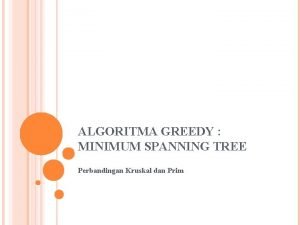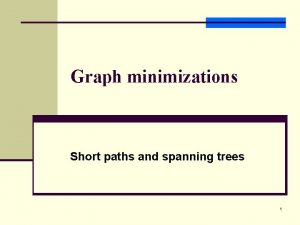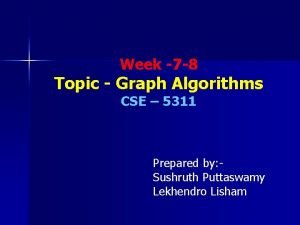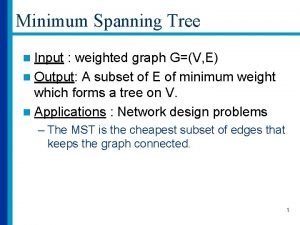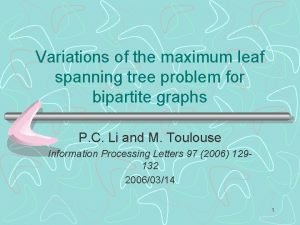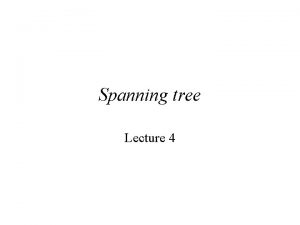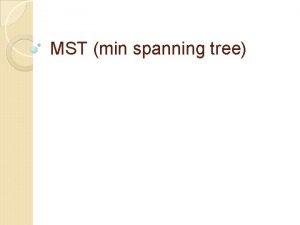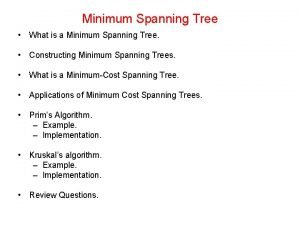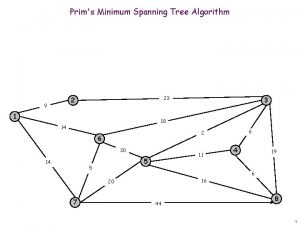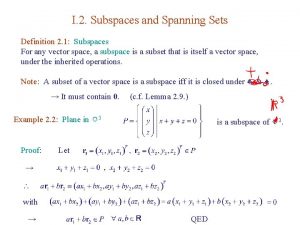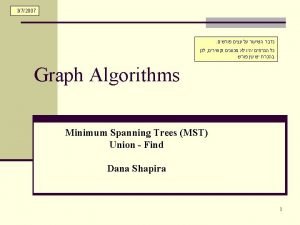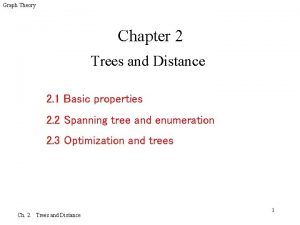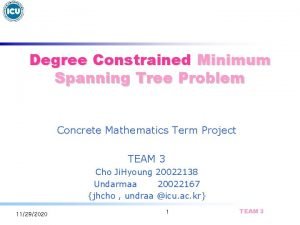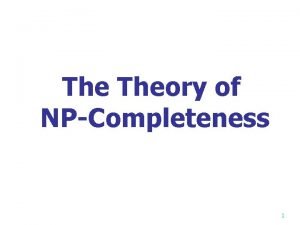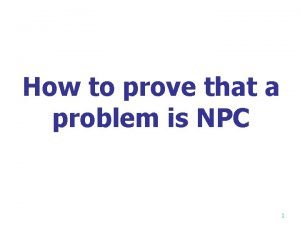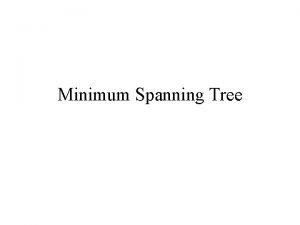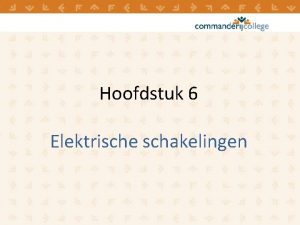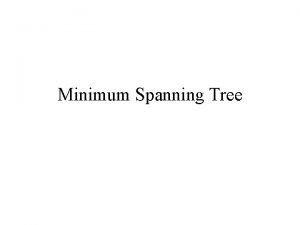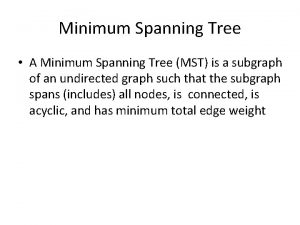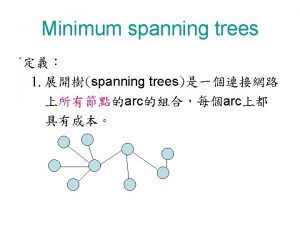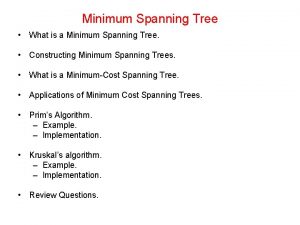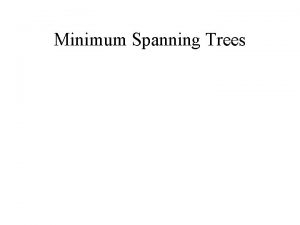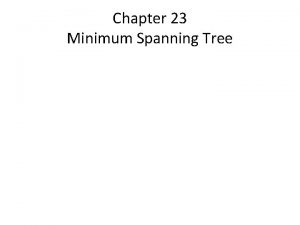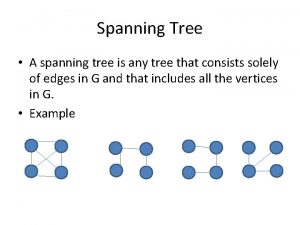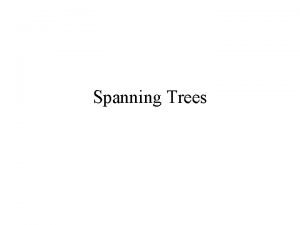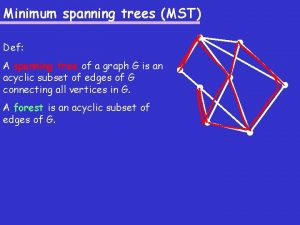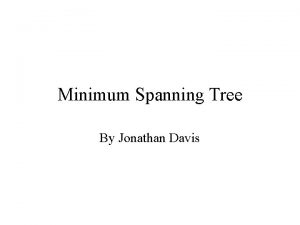Minimum Spanning Tree Minimum Spanning Tree Given a








































- Slides: 40

Minimum Spanning Tree

Minimum Spanning Tree Given a weighted graph G = (V, E), generate a spanning tree T = (V, E’) such that the sum of the weights of all the edges is minimum. Numerous applications, like Minimum cost vehicle routing. Cable laying in a new neighborhood by a cable TV company Approximate solutions to the traveling salesman problem, We are interested in distributed algorithms only The traveling salesman problem asks for the shortest route to visit a collection of cities and return to the starting point. It is a well-known NP-hard problem

Example

Sequential algorithms for MST Review (1) Prim’s algorithm and (2) Kruskal’s algorithm. Prim’s algorithm starts from a single node (as a degenerate spanning tree). Then it adds edges of minimum weights to it to form an MST. Kruskal’s algorithm first sorts the edge weights and stores them in a set S. Then it starts removing the edges of least weight from S and adding them, so that at every stage the topology remains a tree or a forest. It stops when all nodes are covered and a spanning tree is formed. Both are greedy algorithms.

Sequential algorithms for MST Theorem. If the weight of every edge is distinct, then the MST is unique.

Gallagher-Humblet-Spira (GHS) Algorithm Choose this edge to connect them • GHS is a distributed version of Prim’s algorithm. Most famous message passing algorithm for MST. We will study the asynchronous version only 3 7 5 • Bottom-up approach. MST is recursively Tree constructed by joining pairs of Fragment fragments with edges of least cost. Tree Fragment

Challenges Challenge 1. How will the nodes in a given fragment identify the edge to be used to connect with a different fragment? A root node in each fragment is the coordinator. Extensive use of broadcast and convergecast.

Challenges Challenge 2. How will a node in T 1 determine if a given edge connects to a node of a different tree T 2 or the same tree T 1? Why will node 0 choose the edge e with weight 8, and not the edge with weight 4? Nodes in a fragment acquire the same name or label before augmentation.

Two main steps • Each fragment has a level. Initially each node is a fragment at level 0. • (MERGE) Two fragments at the same level L combine to form a fragment of level L+1 • (ABSORB) A fragment at level L is absorbed by another fragment at level L’ (L < L’). The new fragment has a level L’. (Each fragment in level L has at least 2 L nodes. Why? )

Least weight outgoing edge To test if an edge is outgoing, each node sends a test message through a candidate edge. The receiving node may send accept or reject. The root broadcasts initiate within its own fragment, collects the report from other nodes about eligible edges using a convergecast, and determines the least weight outgoing edge. (Broadcast and Convergecast are two handy tools) test accept reject

Accept of reject? Case 1. If name (i) = name (j) then send reject Let i send test to j Case 2. If name (i) ≠ name (j) AND level (i) ≤ level (j) then node j sends accept Name = X L=4 Case 3. If name (i) ≠ name (j) AND level (i) > level (j) then reject test wait until level (j) = level (i) and then send accept/reject. test WHY? (See note below) L=3 Name = Y L=3 (Note that levels can only increase). Question. Can fragments wait for ever leading to a deadlock? Note. It may be the case that the responding node belongs a different fragment when it received the test message, but it is also trying to merge with the sending fragment.

The major steps repeat 1 Test edges as outgoing or not 2 Identify the least weight outgoing edge that becomes a tree edge 3 Send a “join” signal to the other end of the edge (or respond to join) 4 Update level & name & identify new coordinator/root until there are no outgoing edges

Types of messages (Initiate) Root initiates the “lwoe” search (lwoe = least weight outgoing edge) (test) Nodes test if an edge is outgoing (report) Nodes respond to the root with info about outgoing edges (accept) The recipient of the test message certifies the edge as “outgoing” (reject) The recipient of the test message certifies the edge as “not outgoing”

Classification of edges • Basic (initially all branches are basic) • Branch (all tree edges) • Rejected (not a tree edge) Branch and rejected are stable attributes (once tagged as rejected, it remains so for ever. The same thing holds for tree edges too. )

Wrapping it up Merge Example of merge The edge through which the join message is exchanged, changes its status to branch, and it becomes a tree edge. The new root broadcasts an (initiate, L+1, name) message to the nodes in its own fragment. initiate

Wrapping it up Absorb T’ sends a join message to T, and receives an initiate message. This indicates fragment at the level L has been absorbed by the other fragment at level L’. They Example of absorb collectively search for the lwoe. The edge through which the join message was sent, initiate

Example 1 0 8 2 5 1 3 7 4 5 4 6 2 6 9 3

Example merge 1 0 8 2 1 3 7 4 5 4 merge 2 merge 5 6 6 9 3

Example 1 0 8 2 5 1 merge 3 7 4 5 4 6 2 6 9 3 absorb

Example 1 0 absorb 8 2 5 1 3 7 4 5 4 6 2 6 9 3

Message complexity Each edge may be rejected at most once. It requires two messages (test + reject). The upper bound is 2|E| messages. At each of the (max) log N levels, a node RECEIVES at most (1) one initiate message and (2) one accept message and SENDS (3) one report message (4) one test message not leading to a rejection, and (5) one changeroot or join message. So, the total number of messages has an upper bound of 2|E| + 5 N log N

Coordination Algorithms: Leader Election

Leader Election •

Leader Election Difference between mutual exclusion & leader election The similarity is in the phrase “at most one process. ” But, Failure is ruled out in mutual exclusion, a new leader is elected only after the current leader fails. No fairness is necessary - it is not necessary that every aspiring process has to become a leader.

Bully algorithm (Assumes that the topology is completely connected) 1. Send election message (I want to be the leader) to processes with larger id 2. Give up your bid if a process with larger id sends a reply message (means no, you cannot be the leader). In that case, wait for the leader message (I am the leader). Otherwise elect yourself the leader and send a leader message 3. If no reply is received, then elect yourself the leader, and broadcast a leader message. 4. If you receive a reply to the election message, but later don’t receive a leader message from a process of larger id (i. e. the leader-elect has crashed), then re-initiate election by sending election message.

Bully algorithm In the worst case Node 0 sends N-1 election messages Node 1 sends N-2 election messages Node N-2 sends 1 election messages etc Finally, node N-2 will be elected leader, but before it sends the leader message, it crashed. So, 0 starts all over again The worst-case message complexity = O(N 3) (This is bad)

Maxima finding on a unidirectional ring • The ids may not be nicely ordered like this

Bidirectional ring Franklin’s algorithm (synchronous algorithm) In each round, every process sends out probes (same as tokens) in both directions to its neighbors. Probes from higher numbered processes will knock the lower numbered processes out of competition. In each round, out of two neighbors, at least one must quit. So at least 1/2 of the current contenders will quit. Message complexity = O(n log n). Why?

Sample execution

Peterson’s algorithm initially ∀i : color(i) = red, alias(i) = i {program for each round and for each red process} send alias; receive alias (N); if alias = alias (N) I am the leader alias ≠ alias (N) send alias(N); receive alias(NN); if alias(N) > max (alias, alias (NN)) alias: = alias (N) alias(N) < max (alias, alias (NN)) color : = black fi fi {N(i) and NN(i) denote neighbor and neighbor’s neighbor of i}

Peterson’s algorithm Round-based. Finds maxima on a unidirectional ring using O(n log n) messages. Uses an id an alias for each process.

Synchronizers Synchronous algorithms (round-based, where processes execute actions in lock-step synchrony) are easier to deal with than asynchronous algorithms. In each round (or clock tick), a process (1) receives messages from neighbors, (2) performs local computation (3) sends messages to ≥ 0 neighbors Synchronous algorithm synchronizer Asynchronous system A synchronizer is a protocol that helps run the execution of synchronous algorithms on an asynchronous system.

Global vs Local Synchronizers A global synchronizer guarantees that no process receives a message for round r until all processes have sent their messages for round r. A local synchronizer guarantees that no process receives a message for round r until all of its neighbors have sent their messages for round r. [So, a process shouldn’t receive m (for round 2) until all its neighbors finished sending m (for round 1)] Often called Awerbuch’s Synchronizers. Baruch Awerbuch wrote the first paper on this topic. Synchronous algorithm synchronizer Asynchronous system

Local Synchronizers “Every message sent in clock tick k must be received by the neighbors in the tick k. ” Example. Asynchronous Bounded Delay (ABD) synchronizer Start tick 0 tick 1 tick 2 tick 3 Assume that channel delays have an upper bound d Each process will start the simulation of a new clock tick after 2 d time units, where d is the maximum propagation delay of each channel

m ack m m ack Simulation of each clock tick 1. Send and receive messages for the current tick. 2. Send ack for each incoming message, and receive ack for each outgoing message 3. Send a safe message to each neighbor after sending and receiving all ack messages (After receiving safe messages from the neighbors follow steps 1 -2 -3 - …)


MESSAGE complexity of the algorithm implemented on top of the asynchronous platform TIME complexity of the algorithm implemented on top of the asynchronous platform Message complexity of the original synchronous algorithm Time complexity of the original synchronous algorithm in rounds

It is a global synchronizer. Form a spanning tree with any node as the root. The root initiates the simulation of each tick by sending message m(j) for each clock tick j. Each process responds with an ack(j) and then with a safe(j) message along the tree edges (that represents the fact that the entire subtree under it is safe). When the root receives safe(j) from every child, it initiates the simulation of clock tick (j+1) using a next message.

Cluster head •

Example of application: Shortest path Consider Synchronous Bellman-Ford: • MS = O(n |E| ) messages, TS =O(diam) rounds What about Asynchronous Bellman-Ford • Many corrections possible (exponential), due to message delays. • Message complexity can be exponential in n in the worst case • Time complexity exponential in n, counting message pileups. Now, use an α-Synchronizer to run the Synchronous Bellman-Ford : • MA = MS + TS. M(α) = O(n. |E|) + O(diam). O(|E|) = O(n. |E|) • TA = TS. T(α) = 3. O(diam) rounds = O(n) rounds
 Minimum spanning tree
Minimum spanning tree Dijkstra vs prim vs kruskal
Dijkstra vs prim vs kruskal Minimum spanning tree
Minimum spanning tree Minimum spanning tree
Minimum spanning tree Minimum spanning tree
Minimum spanning tree Dijkstra's algorithm proof
Dijkstra's algorithm proof Minimum spanning tree weighted graph
Minimum spanning tree weighted graph Minimum leaf spanning tree
Minimum leaf spanning tree Minimum spanning tree
Minimum spanning tree Minimum spanning tree definition
Minimum spanning tree definition Minimum spanning tree
Minimum spanning tree Minimum cost spanning tree
Minimum cost spanning tree Minimum spanning tree
Minimum spanning tree Minimum spanning tree shortest path
Minimum spanning tree shortest path Subspaces and spanning sets
Subspaces and spanning sets Spanning tree
Spanning tree Forest in graph theory
Forest in graph theory Spanning tree algorithm in computer networks
Spanning tree algorithm in computer networks Petr lapukhov
Petr lapukhov Pohon (tree) adalah
Pohon (tree) adalah Degree constrained spanning tree
Degree constrained spanning tree Pohon berakar yang urutan anak-anaknya penting disebut
Pohon berakar yang urutan anak-anaknya penting disebut Common spanning tree
Common spanning tree Stp priority values
Stp priority values Protocolo spanning tree
Protocolo spanning tree Non-deterministic algorithm
Non-deterministic algorithm Spanning tree definition
Spanning tree definition Csc longin
Csc longin Asus spanning tree protocol
Asus spanning tree protocol Cisco spanning tree best practices
Cisco spanning tree best practices Spanning tree of a graph
Spanning tree of a graph Local minimum
Local minimum Marc bremer
Marc bremer Spanningsloos werken
Spanningsloos werken Spanning trees
Spanning trees Vca toolbox
Vca toolbox Vtp version 3
Vtp version 3 Boundary spanning adalah
Boundary spanning adalah Serieschakeling spanning
Serieschakeling spanning Visual explorer center for creative leadership
Visual explorer center for creative leadership Spanning tussen fase en aarde
Spanning tussen fase en aarde
